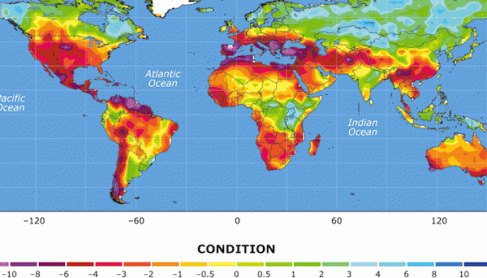NASA has issued a press release stating that in less than a week, the amount of thawed surface ice in Greenland skyrocketed from 40 percent to 97 percent. Normally, Greenland experiences approximately a 50 percent surface ice sheet melt during the summer. The presence of this new increased level of thawing was discovered by NASA’s Jet Propulsion Laboratory. From satellite views, pictures show that it covers nearly all of Greenland’s surface ice cover and is larger than any measurements over the past 30 years. Upon questioning these results, NASA received confirmation from three independent sources, namely, from scientists at NASA’s Goddard Space Flight Center, as well as from the University of Georgia at Athens and the City University of New York.
Mindful of the ongoing debate between climatologists and environmental scientists versus many conservative thinkers and politicians that “global warming” is a myth, NASA’s cryosphere manager, Tom Wagner, states that this phenomenon may be due, in part, to natural variations. On this subject, he points to this year’s unusual weather pattern over Greenland, described as an “unusually strong ridge of warm air”. However, Mr. Wagner notes that this case is “clearly thinning around the periphery, changing Greenland’s overall ice mass”. He states that warming ocean water is eating away the ice.
It appears that the Arctic, in general, is changing due to warmer temperatures. Recent notation was made of an iceberg the size of Manhattan that tore off of the Petermann Glacier in Greenland. Several studies suggest the major role that humans play in ocean warming and point to the fact that several regions of the world, especially the United States east coast, are more vulnerable than other areas to sea level rise. These occurrences appear to be human-induced and offer proof of the harm we are doing to the planet by not adhering to environmentally friendly practices. We need to heed the call of scientists and environmentalists to protect the earth for future generations. Let’s live green, be green!
We all are aware of the breaking environmental news regarding current drought conditions in the United States. Presently, more than half of the United States is suffering from the worst drought conditions since the Dust Bowls, the last of which occurred 50 years ago. We are witnessing wilted crops, particularly corn, dried-out, cracked soil and devastating forest fires caused by parched woodlands. It is important to note that the current drought levels have not reached those of the Dust Bowl where 63% of the country experienced severe drought; however, today’s statistics do place this occurrence in the top 10% for the past century.
Comparisons of statistics for severe droughts in the 1930’s and 1950s have resulted in some assumptions, especially by some politicians and talking heads that the current drought is not caused by global warming. One such argument notes that carbon emissions were lower in the 30s than they are today, so the problem must have been due to some other natural occurrence. Tree-ring data often have been cited to suggest that North American droughts are part of a natural cycle tied to La Nina events. Environmental scientists now are compiling compelling evidence that rising temperatures are making droughts more common, and this phenomenon is less likely attributable to natural causes.
The primary focus now must be on measures to address the problems of climate change. John Antler of Montana State University has published a paper, which proposes that the government shift policies to adapt to climate change, i.e., providing subsidies for crops such as corn and soy to prevent adaptation by locking in current farming patterns. (http://www.rff.org/news/features/pages/climate-change-forcing-farmers-to-adapt.aspx) Tom Philpott recommends a stronger push towards organic farming. Recent research concludes that while organic farming yields smaller crop production, the organic farming process holds retains more water and performs better during droughts (http://www.motherjones.com/tom-philpott/2012/07/what-organic-ag-teaches-us-about-feeding-ourselves-while-planet-heats).
Currently, the United States has not been impacted as severely as many other nations by drought and destruction of food supply. However, we see the effects of droughts in terms of increasing prices for food and increasing disasters, such as forest fires and parched land. Droughts are becoming difficult to avoid, and steps must be taken immediately to protect our land, population and food sources. Our very existence depends on this. To save our world, let’s live green, be green.
The Palmer Drought Severity Index mid-century. A reading of -4 or below is considered extreme drought. (Source: National Center for Atmospheric Research).

